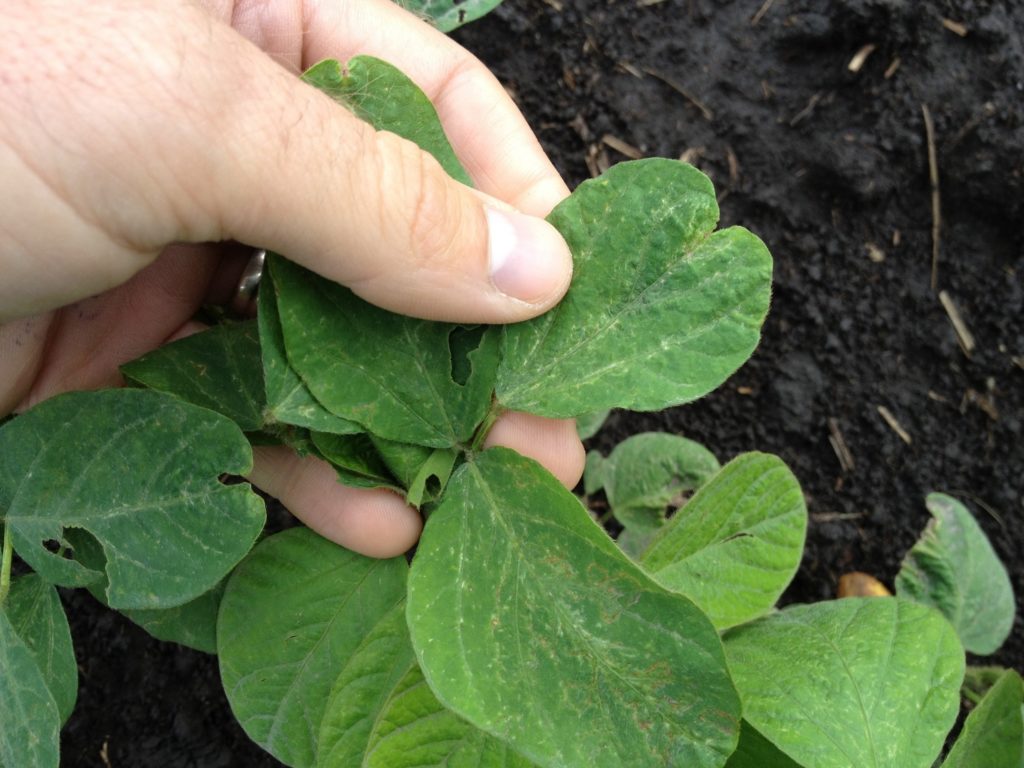Early-Season Soybean Leaf Puckering, Deformation, and Damage From Herbicides and Insects
go.ncsu.edu/readext?604520
en Español / em Português
El inglés es el idioma de control de esta página. En la medida en que haya algún conflicto entre la traducción al inglés y la traducción, el inglés prevalece.
Al hacer clic en el enlace de traducción se activa un servicio de traducción gratuito para convertir la página al español. Al igual que con cualquier traducción por Internet, la conversión no es sensible al contexto y puede que no traduzca el texto en su significado original. NC State Extension no garantiza la exactitud del texto traducido. Por favor, tenga en cuenta que algunas aplicaciones y/o servicios pueden no funcionar como se espera cuando se traducen.
Português
Inglês é o idioma de controle desta página. Na medida que haja algum conflito entre o texto original em Inglês e a tradução, o Inglês prevalece.
Ao clicar no link de tradução, um serviço gratuito de tradução será ativado para converter a página para o Português. Como em qualquer tradução pela internet, a conversão não é sensivel ao contexto e pode não ocorrer a tradução para o significado orginal. O serviço de Extensão da Carolina do Norte (NC State Extension) não garante a exatidão do texto traduzido. Por favor, observe que algumas funções ou serviços podem não funcionar como esperado após a tradução.
English
English is the controlling language of this page. To the extent there is any conflict between the English text and the translation, English controls.
Clicking on the translation link activates a free translation service to convert the page to Spanish. As with any Internet translation, the conversion is not context-sensitive and may not translate the text to its original meaning. NC State Extension does not guarantee the accuracy of the translated text. Please note that some applications and/or services may not function as expected when translated.
Collapse ▲By: Dominic Reisig and Wes Everman
We handle situations every year regarding early-season leaf injury and damage. This year, the volume of questions has been higher and is likely related to this year’s particular environment. We hope to disentangle some of what folks might be seeing in this short article, but want to make the most important point now that all of what we’ve seen so far is cosmetic and will have no impact on yield.
Thrips. Most folks that have experience in cotton immediately think of thrips when they see leaf distortions. Entomologists across the southern US experience with lots of replicated trials where we can reduce thrips populations with insecticides, either on the seed, or sprayed. By knocking back thrips, we can compare damaged to undamaged plots. Thrips will cause silvering of the leaves. This photo shows populations that were as high as 75 thrips per seedling (a population level that could kill a cotton seedling under the right conditions). While the stippling is from the thrips, the leaf deformation is not caused by thrips.
Most importantly, we have nearly 40 replicated trials in North Carolina and Virginia with conditions ranging from early planted, late planted, dry, wet, cold, hot and have never seen a yield advantage to treating thrips. So their damage is merely cosmetic.
Herbicides. The soybean leaf in the photo with the heart shape is probably not new to most agronomists and farmers. It is often associated with the chloroacetamide family of herbicides. These herbicides include products containing metolachlor (Dual, Cinch, Brawl, Me-Too-Lachlor), acetochlor (Warrant), dimethenamid (Outlook), and pyroxasulfone (Zidua, Anthem Flexx, Fierce). These are shoot inhibitors and work by keeping the leaves of weeds from growing correctly. When weather conditions are right (wet and cool usually) when the seedling emerges, even crop plants can be impacted. This is typically cosmetic and does not impact long term soybean growth and yield.
So what is causing this deformation and puckering? Under some situations it could be herbicide carry over, but, based on what some growers have used this year that can be ruled out in certain fields. Another concern that may arise would be potential off-target movement of dicamba or another growth regulator which can also cause some deformation and puckering. Again, there have been situations where this could be ruled out (Xtend soybeans showing the deformation for example). There is also the possibility that these symptoms are due to a physiological response due to weather conditions. It has been reported in Illinois that this has been observed after the first few days the soybeans have been exposed to air temperatures of 90 degrees or greater. It is hypothesized that the soybeans are rapidly growing and hormone regulation in the leaf is disrupted. This has not been confirmed through replicated research at this point.
While the puckering in these cases is from unknown causes (see photos below), we again want to reiterate that all of what we’ve seen so far is cosmetic and will have no impact on yield. A good rule of thumb is to look at the newest emerging leaves; if the newer leaves look normal and growing conditions are good, your soybeans are on the right track. If off target dicamba movement is suspected, or if you have any other concerns, please contact your local N.C. Cooperative Extension office for help.





